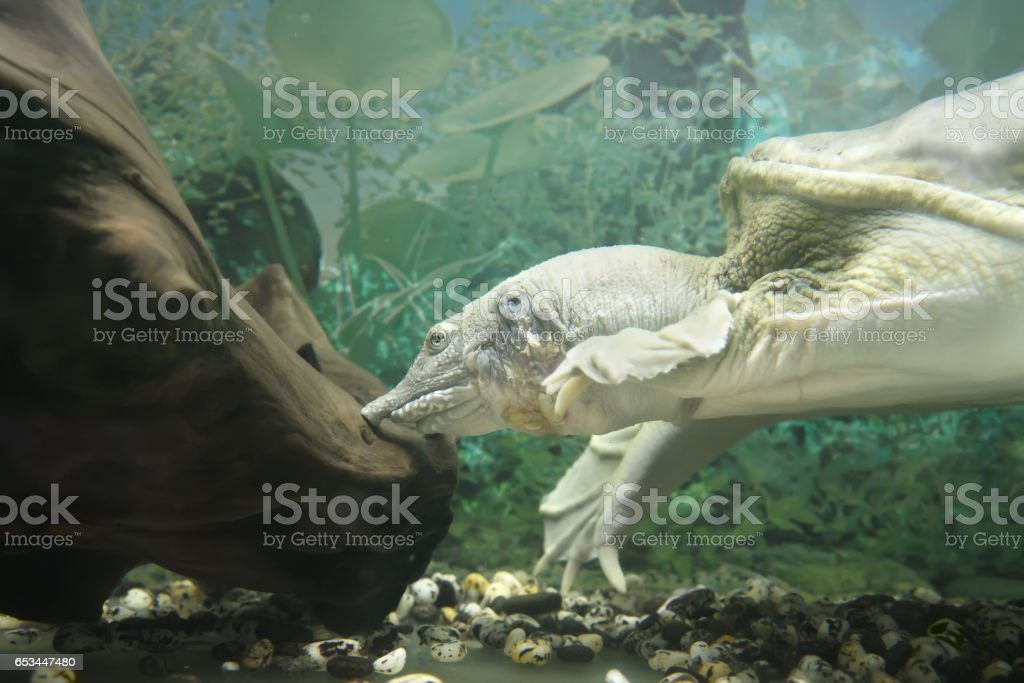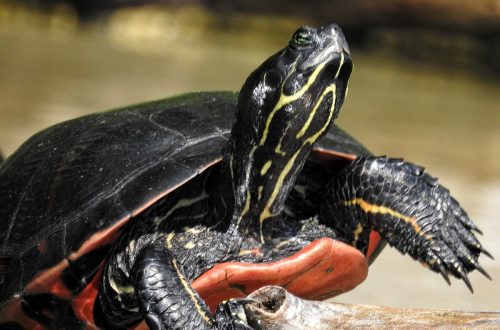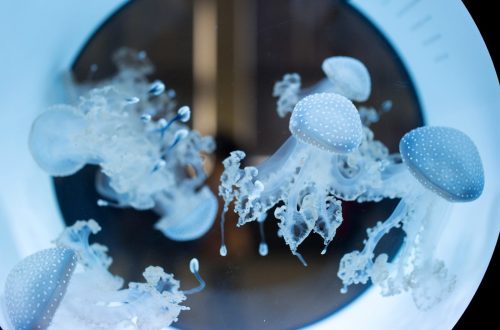
Far Eastern (Chinese) Trionics.
Unlike the soft-bodied man, the soft-bodied turtle Trionics has a predatory aggressive disposition. Despite this, their popularity among tortoise breeders and just reptile lovers is growing.
It is not very usual that their shell is covered not with hard plates, but with skin (hence this genus of turtles got its name – soft-bodied). In addition to this feature, trionics have a long flexible neck that can bend and reach almost to the tail and powerful jaws with a cutting edge.
This is a completely aquatic turtle that lives in its natural environment in freshwater reservoirs with a muddy bottom. They come out of the water completely only to lay eggs. But on warm sunny days, they can bask near the surface of the water or clinging to a snag. For better camouflage, the turtle has a marsh-green skin on top and white underneath.
If you consciously decide to have such a predator at home, you need to take care of creating suitable conditions for it.
Trionixes grow up to about 25 cm. For maintenance, you will need a spacious horizontal terrarium, but at the same time it is high enough or has a lid, since, despite the aquatic lifestyle, these turtles can easily get out of the terrarium. The water temperature should be approximately 23-26 ºC, and air 26-29. An island is not required for these turtles, as a rule, they do not crawl out on it, and use it only during oviposition. But you can put a small snag, without sharp edges, in order to avoid injury to the soft skin.
In addition to the heat lamp, an ultraviolet lamp for reptiles with a UVB level of 10.0 is needed, at a distance of approximately 30 cm from the surface of the water. It is necessary to change the lamp, as with the content of other reptiles, every 6 months. Ultraviolet does not pass through glass, so it is necessary to install the lamp directly in the terrarium, but so that Trionics cannot reach it and break it.
In nature, turtles burrow into the ground where they feel safe. The pet will be calmer and more pleasant to live if you provide him with such an opportunity in the aquaterrarium. The best substrate is sand, and the soil should be deep enough for the turtle to burrow into (about 15 cm thick). Stones and gravel are not the best option, as they can easily injure the skin.
In the breath of these turtles, too, there are a lot of interesting points. They breathe not only atmospheric air, sticking out their snout nose, but also air dissolved in water due to skin respiration and villi on the mucous membrane in the throat. Thanks to this, they can stay under water for a long time (up to 10-15 hours). Therefore, the water in the terrarium should be clean, with good aeration. At the same time, it must be remembered that Trionics are prone to destructive behavior, and with pleasure at their leisure they will try filters, lamps, and aeration devices for strength. So all this must be protected and protected from vicious predators.
The main food, of course, should be fish. To please the gambling hunter, you can put live fish into the aquarium. Low-fat varieties of fresh raw fish are suitable for feeding. Sometimes you can give organ meats (heart, liver), insects, snails, frogs. Young turtles are fed daily, and adults once every 2-3 days.
A necessary supplement should be vitamin and mineral supplements for reptiles, which must be given by weight along with food.
Trionix is a very active, unusual, interesting, but not the friendliest pet. A turtle raised at home from a young age may well take food from the hands and be given to the hands without a fight. But you still need to be careful, take the turtle closer to the tail by the shell, and if you are not sure of its favorable location, then it is better to do this with gloves. The jaws of these turtles are a formidable weapon even for humans, and their aggressive nature will most likely not tolerate a familiar intrusion into their life and space. Such turtles do not get along with other animals and are capable of inflicting deep injuries on them.
So, what you need to remember for those who decide to have a Far Eastern Trionix:
- These are aquatic turtles. Drying out is dangerous for them (do not keep them without water for more than 2 hours).
- For maintenance you need a spacious high horizontal terrarium, preferably with a lid.
- Water temperature should be 23-26 degrees, and air 26-29
- A UV lamp with a level of 10.0 is required
- Sand is best suited as soil, the thickness of the soil should be about 15 cm.
- Trionixes need land only for laying eggs; in a terrarium, you can get by with a small snag, without sharp edges.
- Aquarium water should be clean and oxygenated.
- The best food for turtles is fish. But it is imperative to include calcium-containing top dressing for reptiles in the diet throughout life.
- When dealing with a turtle, do not forget about its sharp powerful jaws.
- Equip the terrarium to the conscience, remember that Trionix will try to break or destroy everything that it can reach.





